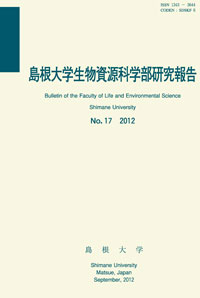島根大学生物資源科学部
ISSN:2435-0885(オンライン)
ISSN:1343-3644(冊子体)
なお、冊子体の刊行は23巻まで
ISSN:1343-3644(冊子体)
なお、冊子体の刊行は23巻まで

ダウンロード数 : ? 件
この文献の参照には次のURLをご利用ください : https://ir.lib.shimane-u.ac.jp/4377
島根大学生物資源科学部研究報告 5
2000-12-20 発行
流域内の降雨分布特性を組み込んだ洪水流出解析法
A New Technique of Flood Runoff Analysis considering the Characteristics of Rainfall Distribution in a Watershed
ファイル
内容記述(抄録等)
A method of flood runoff analysis is proposed for routing spatiall distributed excess rainfall over a watershed to produce runoff at its outlet. The outline is as follws :
Two runoff models are constracted as distributed types. The first one is a modfied model from the Long- and Short- Terms Runoff Model(LST-II model), which is developed by Kadoya and Nagai(1988)for analyzing both flood and long term runoff successively. The other is developed for the Kinematic Wave Storage Model(KiWS model), which is combined kinematic wave runoff model with the LST-II model.
Both models are applicable to analyze a runoff phenomena considering the spatially distibuted precipitation obseryed by radar rainfall measurement system. In order to utilize the radar mesh data in runoff analysis, the routine phase of rainwater flow on hillslope is expressed by the series of the LST-II model or the KiWS one. The slope system of the runoff model is divided to any zones according to the slope length. At each zone of the slope system, the rainfall series at the unit or multiple mesh area by radar measurement are supplied as input data to the runoff model. In the series of the LST-II model, input rainfall is stored to upper part of first tank and distributed automaticaiiy each runoff components. In the series of the KiWS model, effective rainfall at each zone of the slope system is automatically culculated by utilizing the structure of the LST-II model. And stream flow in a stream network is expressed by the kinematic waye model. Finally, we illustrate the use of this method for a storm occured on the 24th of September, 1999 over the Hii River basin.
Two runoff models are constracted as distributed types. The first one is a modfied model from the Long- and Short- Terms Runoff Model(LST-II model), which is developed by Kadoya and Nagai(1988)for analyzing both flood and long term runoff successively. The other is developed for the Kinematic Wave Storage Model(KiWS model), which is combined kinematic wave runoff model with the LST-II model.
Both models are applicable to analyze a runoff phenomena considering the spatially distibuted precipitation obseryed by radar rainfall measurement system. In order to utilize the radar mesh data in runoff analysis, the routine phase of rainwater flow on hillslope is expressed by the series of the LST-II model or the KiWS one. The slope system of the runoff model is divided to any zones according to the slope length. At each zone of the slope system, the rainfall series at the unit or multiple mesh area by radar measurement are supplied as input data to the runoff model. In the series of the LST-II model, input rainfall is stored to upper part of first tank and distributed automaticaiiy each runoff components. In the series of the KiWS model, effective rainfall at each zone of the slope system is automatically culculated by utilizing the structure of the LST-II model. And stream flow in a stream network is expressed by the kinematic waye model. Finally, we illustrate the use of this method for a storm occured on the 24th of September, 1999 over the Hii River basin.
About This Article
Other Article
